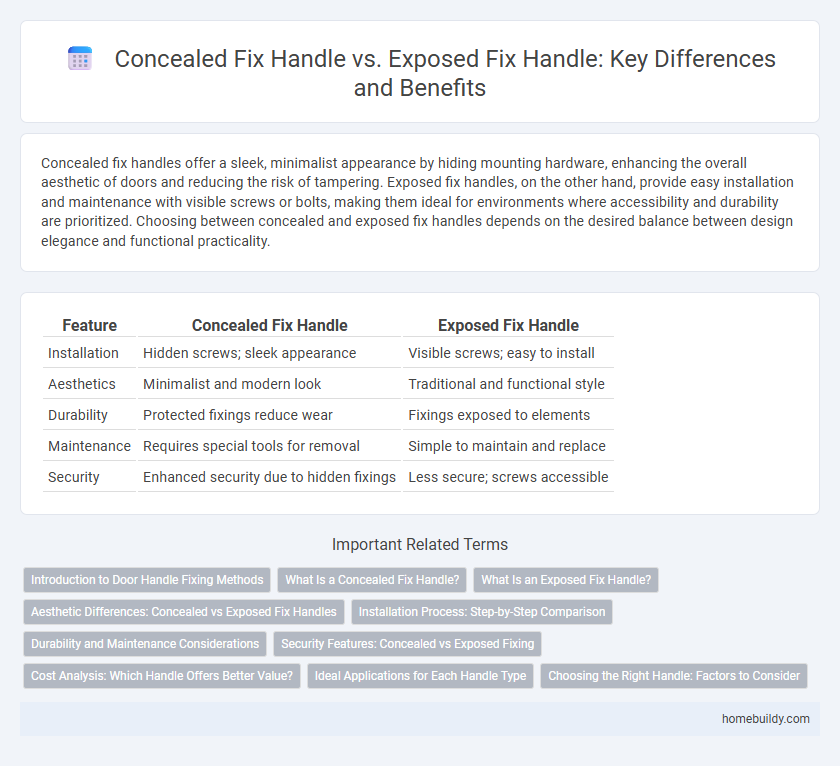Concealed fix handles offer a sleek, minimalist appearance by hiding mounting hardware, enhancing the overall aesthetic of doors and reducing the risk of tampering. Exposed fix handles, on the other hand, provide easy installation and maintenance with visible screws or bolts, making them ideal for environments where accessibility and durability are prioritized. Choosing between concealed and exposed fix handles depends on the desired balance between design elegance and functional practicality.
Table of Comparison
| Feature | Concealed Fix Handle | Exposed Fix Handle |
|---|---|---|
| Installation | Hidden screws; sleek appearance | Visible screws; easy to install |
| Aesthetics | Minimalist and modern look | Traditional and functional style |
| Durability | Protected fixings reduce wear | Fixings exposed to elements |
| Maintenance | Requires special tools for removal | Simple to maintain and replace |
| Security | Enhanced security due to hidden fixings | Less secure; screws accessible |
Introduction to Door Handle Fixing Methods
Concealed fix handles feature internal mounting points hidden from view, offering a sleek and modern appearance while protecting fasteners from tampering and corrosion. Exposed fix handles have visible screws or bolts on the handle surface, enabling easier installation and maintenance but potentially compromising aesthetics. Choosing between concealed and exposed fix methods depends on security needs, design preferences, and ease of access for repairs.
What Is a Concealed Fix Handle?
A concealed fix handle is a type of door handle designed with mounting hardware hidden from view, creating a sleek and uninterrupted surface. This handle is installed by securing the fixing mechanism inside the door or behind the handle plate, enhancing aesthetic appeal and reducing tampering risks. Commonly used in modern cabinetry and minimalist interior designs, concealed fix handles offer a clean, streamlined look while maintaining functional durability.
What Is an Exposed Fix Handle?
An exposed fix handle is a door handle installation method where the screws or fixing elements remain visible on the surface of the handle or door, providing easy access for maintenance or replacement. This type of handle often features decorative screw heads that can complement the handle's design, commonly found in traditional or rustic door hardware styles. Exposed fix handles offer straightforward installation and durability, making them suitable for both interior and exterior doors.
Aesthetic Differences: Concealed vs Exposed Fix Handles
Concealed fix handles offer a sleek, minimalist appearance by hiding screws and mounting hardware, creating a smooth surface that blends seamlessly with the door design. Exposed fix handles feature visible screws or bolts, adding an industrial or decorative element that can enhance rustic or modern aesthetics. The choice between concealed and exposed fix handles significantly impacts the door's overall visual appeal and style coherence.
Installation Process: Step-by-Step Comparison
Concealed fix handles require precise measurement and embedding into the door surface, typically involving drilling and mortising to hide screws, which demands advanced tools and skills for flush mounting. Exposed fix handles have visible screws, allowing straightforward installation by simply aligning the handle, marking screw holes, and screwing it onto the door surface, making the process quicker and less technically demanding. Both methods require accurate alignment, but concealed fix handles offer a cleaner aesthetic at the cost of increased installation complexity and time.
Durability and Maintenance Considerations
Concealed fix handles offer superior durability due to hidden screws protecting them from wear and environmental exposure, reducing the risk of loosening or corrosion over time. Maintenance for concealed fixes is minimal as the components remain sheltered, preventing dirt and moisture buildup that often causes damage. In contrast, exposed fix handles require more frequent checks and tightening, with visible fixing points prone to rust and damage, impacting long-term reliability.
Security Features: Concealed vs Exposed Fixing
Concealed fix door handles offer enhanced security by hiding screws and fixing points, making it difficult for intruders to tamper with the fittings. Exposed fix handles have visible screws, which can be easily unscrewed or tampered with, posing a higher risk in security-sensitive environments. The concealed mounting method also protects against loosening over time, maintaining a strong and secure attachment.
Cost Analysis: Which Handle Offers Better Value?
Concealed fix handles typically command higher initial costs due to complex installation requirements and specialized hardware, while exposed fix handles are generally more affordable and easier to install. Maintenance expenses for concealed handles may be lower over time because their hidden fittings reduce wear and damage exposure, potentially offsetting upfront investment. Evaluating long-term value involves balancing upfront installation costs with durability and ease of maintenance for each handle type.
Ideal Applications for Each Handle Type
Concealed fix handles are ideal for applications requiring a sleek, minimalist appearance and enhanced security, commonly used in modern residential doors, high-end cabinetry, and commercial interiors where aesthetics and tamper resistance are priorities. Exposed fix handles are suitable for heavy-duty doors, industrial environments, and outdoor settings where ease of installation, maintenance accessibility, and robustness are critical. Selecting the appropriate handle type depends on balancing design preferences, functional requirements, and installation conditions.
Choosing the Right Handle: Factors to Consider
Choosing the right door handle involves evaluating factors such as aesthetic preferences, installation complexity, and durability requirements. Concealed fix handles offer a sleek, minimalist look by hiding screws, ideal for modern designs and preventing tampering. Exposed fix handles are easier to install and maintain, suitable for high-traffic areas where quick replacements and robust construction are priorities.
Concealed fix handle vs Exposed fix handle Infographic

 homebuildy.com
homebuildy.com